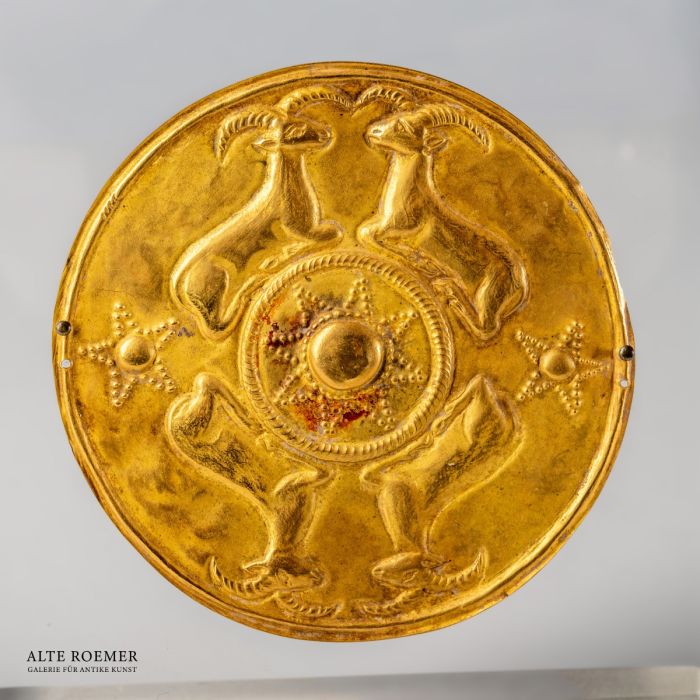Decorative disc of the Amlash culture
Price: on request
Sold
Object number
AR3553
| Object: |
Decorative disc of the Amlash culture
|
| Material: |
Gold.
|
| Period: |
Circa 9th century BC to 7th century BC Iron Age II to III. |
| Description: |
A disc made of thin gold sheet, artfully crafted using the repoussé technique. The relief depicts a central, rounded boss surrounded by decorative dots forming an eight-pointed star. This star is embedded in a seemingly twisted ring. On each side of the central motif is a five-pointed star. Between each of these is a pair of reclining, facing ibexes. The ornaments and depictions on the decorative disc are harmonious due to their symmetry. The artistic execution is characterized by high precision and technical skill. The consistent contours and rhythmic spacing of the elements testify to the artisan's aesthetic sensibility. This piece sheds light on the imagery of the prehistoric Amlash culture in northwestern Iran. For a comparable decorative disc in the Metropolitan Museum of Art the museum suspects it was used as the final decoration for a sword or dagger pommel. |
| Dimensions: |
7.3cm diameter. The modern acrylic glass stand is 11.0cm high and 10.2cm wide.
|
| Condition: |
Perfect condition. Completely preserved from original material and intact. The gold sheet has been bent into its original shape and carefully smoothed, without cracks and now almost completely in one plane. Red deposits in the center of the disc. Two adjacent ancient holes on each side for mounting the disc. Two of these were used to attach the sheet to an acrylic glass stand with metal nails, allowing it to face the viewer directly. A sticker with the inscription "A154" is on the back of the modern stand. A magnificent piece.
|
| Provenance: |
Acquired by us in 2024 from the US art market. Previously in the US collection of the Alsdorf family. Acquired into this collection in February 1966 from the New York Royal Athena Galleries. A copy of the 1966 receipt is available to us. The important private collection of the Chicago couple James W. Alsdorf (1913–1990) and Marilynn B. Alsdorf (1925–2019) was established between the 1950s and 1980s and included works from various cultures and eras. Their particular interest in ancient Near Eastern art was reflected in numerous objects. Marilynn Alsdorf donated around 400 works from the collection to the Art Institute of Chicago in 1997. Further works from the collection returned to the art market via auctions starting in 2020. This object was cross-referenced in 2024 with the Art Loss database, which currently contains over 500,000 objects reported as stolen or lost and also actively integrates the corresponding Interpol and FBI databases. |
| Publications: |
Exhibited at the Art Institute of Chicago from 17 November 1973 to 20 January 1974. Described and illustrated in the accompanying exhibition catalogue, Near Eastern Art in Chicago Collections (The Art Institute of Chicago, 1973), no. 197.
|
| References: |
Cf. Metropolitan Museum of Art, Obj. no. 1989.281.29. For a comparable piece on the art market, see Bonhams London "Antiquities" sale of 7 July 2016, lot 134, estimated at GBP 8,000 to 10,000 (approximately EUR 13,000 to 16,000 including buyer's premium). |
| Authenticity: |
We unconditionally guarantee the authenticity of every artefact, all items are subject to our lifetime return policy on authenticity.
|


